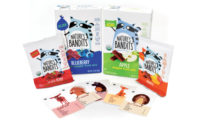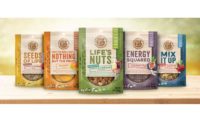Insights & Advice from Sloat Design Group

Creating and revitalizing health-conscious brands comes naturally for Carrie Dufour, founder and creative director of Sloat Design Group. Her team’s focus on brand development and package design has helped such brands as Alexia, So Delicious and Mommy’s Bliss express their unique brand personality. Sloatdesign.com
BRANDPackaging: what is packaging’s role in brand awareness?
Carrie: Packaging plays the lead role in brand awareness for retail products. The right use of colors, textures, imagery and key messages should not only create brand awareness, but packaging should also be distinct and memorable enough to help consumers recall the brand. Color is especially key because it’s what the eye sees first and what many shoppers look for when searching for products. Many consumers won’t remember the name of the brand or product, yet they remember the bright green package or that it has a farmer on the front.
Bp: What are some of the biggest challenges brands face today?
Carrie: Many brands struggle to define and authentically communicate their brand’s story in a way that not only resonates with consumers on shelf but is simple enough for them to remember and repeat to their friends. Even with established companies, defining the brand’s essence and point of difference is always our first step—it sets the foundation for everything we do moving forward. Another frequent challenge is maintaining consistency as a brand grows. Many brands fall into the trap of changing their entire look and feel in different categories to appeal to various audiences. Flexibility in a brand is essential, but in order to build awareness and trust, a certain level of consistency and predictability needs to remain.
Bp: what are some of the considerations when designing for organic brands?
Carrie: Organic products are usually priced higher than their conventional counterpart, so the package design needs to work hard to justify the price by clearly expressing the product benefits and the brand’s values or purpose. The brand’s purpose has the potential to really connect on an emotional level with the consumer. Then the purchase decision can become less about price and more about the shopper choosing the brand that aligns with their values. Developing the right hierarchy on an organic package is also a big consideration. Of course “Organic” should be loud and clear, but there can be several additional certifications and health claims that can quickly clutter up the package. We work closely with our clients to understand the appropriate hierarchy and organize the information in a way that highlights the key messages and improves shopability.
Bp: what are your predictions for the future of sustainability and packaging design?
Carrie: I think “reduce, reuse, recycle” will continue to be the mantra but maybe with more importance placed on reducing and reusing. From a design perspective, packages will probably get smaller so the graphics on shelf will need to work that much harder to stand out. There is a lot of waste in e-commerce currently, and I would guess that we’ll see many innovations in packages specifically designed for shipping. I also think more companies will strive to have their packaging align with their values. For example, if they stand for only Non-GMO ingredients they’ll want to make sure that the soy inks and other materials used in their packaging come from Non-GMO, sustainable sources.
Looking for a reprint of this article?
From high-res PDFs to custom plaques, order your copy today!






